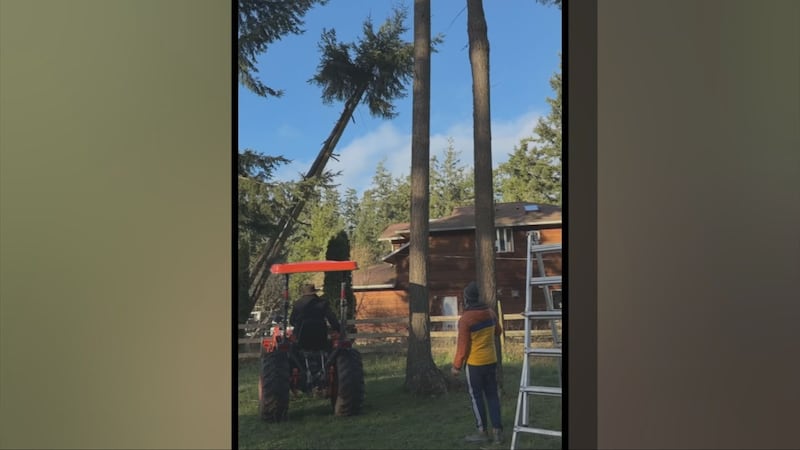Two days after Melissa Burns' homeless tent encampment was cleared out in Seattle, a crew of homeless volunteers helped her build a larger encampment -- half a block away, on a downtown Third Avenue sidewalk.
SEATTLE — The structure, with glass French doors connected to wooden-pallet walls surrounding their interior furniture, can be seen by Seattle tourists heading up and down the Space Needle elevators.
"When in Rome, you modify, adapt and overcome," said one of the homeless carpenters who built the structure, which passers-by dubbed the "tent mansion."
Burns said she and her boyfriend came to Seattle from West Virginia because they "appreciate Seattle's liberal vibe.”
Burns and her boyfriend were previously contacted by Seattle’s Navigation Team -- a group of outreach workers teamed with specially trained Seattle police -- last month when they lived a block away.
"We don't want to change our lifestyle to fit their requirements," she said.
On March 29, the navigation team gave Burns a notice to remove all property on 3rd Avenue from Clay Street to Denny Way. She and her boyfriend moved down the block. The city has not moved them since.
"We're homeless, so we're solving that problem," Burns said. "We are creating a home here."
Seattle police and fire responded Monday evening to the “tent mansion” near the Space Needle after smoke was seen.
But after determining it was a cook stove -- one preparing steaks and shrimp -- police and fire left without incident. Police have previously said people cannot legally have a barbecue on a Seattle sidewalk, citing a section in the Seattle Municipal Code.
Officers who contacted the homeless campers on Monday did not issue citations. Officers told them said they’d contact the Navigation Team “and work with them for the three-day notice” to move, Burns said. Burns and her boyfriend said they’d move along when that happens. But they don’t expect to go far – possibly two blocks away, similar to their last move.
The Seattle city navigation team said only 37 percent of homeless people they contact accept offers of shelter.
When Burns was asked earlier this month if she would accept permanent housing offers, she said she wouldn’t likely accept them.
"We intend to stay here," she said. "This is the solution to the homeless problem. We want autonomy, right here."
The city of Seattle told KIRO 7 they've gotten complaints about 400 unsanctioned homeless encampments. They say their outreach teams are stretched so thin they average removing only two to three per week.
In April of 2017, the city of Seattle implemented new encampment removal rules.
The city is recording encampment removals they complete and documenting them at this link. A city-created map shows emphasis areas where they have decided encampment is a consistent problem.
Seattle officials say their cleanups are prioritized based on health and safety issues. The city must prominently post a notice ahead of an encampment removal on each tent or structure that will be removed at least 72 hours ahead of time.
The notice must contain contact information for a provider of alternative shelter options.
Outreach personnel, who make shelter alternatives and other available services known, must also visit the encampment site at least once between the time the notice of removal is posted and the removal date.
One Seattle photographer has been documenting the homeless in Seattle with portraits and personal narratives for the last eight years.
Rex Hohlbein was once an architect.
He had a practice for 28 years. When he moved into a new Fremont office -- a house on the Burke-Gilman Trail along the ship canal -- he started meeting homeless people: "morning coffees, lunch breaks and such."
During these encounters, his stereotypes were dissolved by the kindness and intelligence of those he met.
He offered them use of the bathroom in his office.
Word spread quickly; soon the homeless were coming all day long. They were respectful.
"Their kindness created more kindness within me," said Seattle's Hohlbein.
It became impossible to turn anyone away, he said.
Facing Homelessness, the name of Hohlbein's Facebook page where he shares intimate photographs of Seattle's homeless, and their stories, is followed by around 50,000 people.
Hohlbein calls the Seattle project’s Facebook page an "empathy wishing-well."
"It just matters that (you’re doing) something,” says Hohlbein. “We think of it as this level line. On one end of the line is just saying, 'Hello.' On the other end is something extreme -- like bringing someone into your home to live with you. In between those two points are seven billion-plus docking points."
Below is an excerpt from a post a few years ago on Facing Homelessness that addresses clearing out homeless camps:
"The Seattle Parks & Recreation Department walks a fine line when working with those who have no option but to sleep outside. My heart goes to them for finding the balance between enforcing park-laws while at the same time being ever compassionate.
"Pushing folks out of the parks, only for them to relocate somewhere else, somewhere where the clock begins ticking immediately for the next forced move, is not only wasteful, it is demoralizing to those trying to create some sense of home.
"Yesterday early morning, three policeman and about ten Parks Department employees were making sure that Ronnie LaBranche and Sherri Dixon moved their tents and belongings somewhere else, to where nobody had an answer for -- just somewhere else."
More news from KIRO 7
- The Latest: Military plane crashes in Algeria, 257 dead
- Burglar accused of breaking into home, renting it out
- Audit: SPD struggling to recover staffing costs from officers working special events
- Sawant: Seattle a 'playground for the rich,' protests outside Amazon
- 4 suspects captured in Rainier Valley after shots fired in Central District
Cox Media Group






